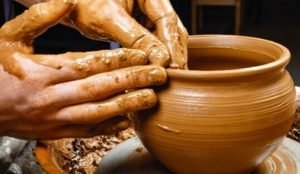What is Clayey Soil? its 4 Types, Formation, Uses, & Advantages
Clayey soil is a type of soil that benefits from high nutrients or the soil that is comprised of very fine mineral particles and not much organic material is called clayey soil.
Clayey soil consists of very fine particles of clay and has a high capacity for water holding. Wet clay soil is very sticky and contains very little air and in clay, the size of soil particles is less than 0.2mm, and inorganic matter in clayey soil is rich.

Over 25 per cent of clay in these soils are made and clayey soil holds a high amount of water because of the spaces found between clay particles. For crops like paddy which require a lot of water, this soil is only good but not good for many plants. For making toys, pots, and many other purposes, clay is used.
This soil is composed of millions of clay particles which are 0.002 millimetres (0.0000787 inches) in diameter. These particles are tightly spaced so that for having poor water or air movement throughout, the clay is notorious.
Formation of Clayey Soil:
The clay is a loose, soft earthy material that contains particles with a grain size of fewer than 4 micrometres and as a result of the weathering and erosion of rocks containing the mineral group feldspar over vast spans of time, it is formed.
The feldspar (known as the mother of clay) content is altered by reaction with water to form clay minerals such as kaolinites and smectites.

It occurs when water rushes over the surface of rock and erosion is one source of particles for clayey soil. The weathering of rocks and soil is the largest source of clay particles and both physical and chemical changes take place that create the small particles required to form clay soil during weathering.
Another source of clay particles is the process that occurs when minerals that are stable in one environment destabilize because of compaction or burial.
Types of Clayey Soil According to Percentage:
Depending on the amount of clay in the soil there are four types of clayey soil that differ in characteristics. The types are given below according to the different percentages of clay soil;
- Silt Soils with 0 – 10 Percent Clay
- Clay Soils with 10 – 25 Percent Clay
- Clay Soils with 25 – 40 Percent Clay
- Clay Soils with 40 Percent Clay
Silt Soils with 0 – 10 Percent Clay:
To form a crust that makes the soil hard this type of soil has a propensity and it will become very compact and water will not be able to permeate the soil due to this you cannot over-till this soil.
This type of soil is generally easy to till but in wet conditions, you should not till this type of soil.
Clay Soils with 10 – 25 Percent Clay:
This type of soil has a low amount of clay and organic material so it is difficult to till this type of clayey soil. Crusting with this type of soil can be really significant.
Clay Soils with 25 – 40 Percent Clay:
This type of soil is dark in colour and to be cultivated correctly it must be tilled with the correct water content. The clay can clod if the environment runs very dry.
Clay Soils with 40 Percent Clay:
In order to be considered an optimal soil heavy clay soils need a lot of recompacting and they cannot be tilled in wet conditions but it is very nutrient-rich.
Uses of Clayey Soil:
There are the following uses of this soil such as;
- Some plants like apple, elm, ash, willow, tamarack, and many other plants can be grown by using clay soil but not all plants can be grown in this soil.
- Because of its extraordinary properties, this soil has been used for construction. By drying it in the sun or by burning it in the fire, clay can be made into adobe bricks and built into a house, the bricks are then got together along with mortar which is another component made up of clay.
- When water is mixed with it, clay has the ability to be moulded into different sorts of shapes and structures and to make pots, pipes, and other useful objects that can be used for household purposes, clay can be used. For ceramics by ceramicists, clay is used.
- For pottery clayey soil is also used but this is a lengthy process and takes several hours to complete because the clay must be heated slowly.
- The minerals of clay soil have been used in the folk medicinal field because mineral contents of clay soil help to provide relief for wounds and upset stomach infections and clay soil has minerals with antimicrobial properties that are effective in killing pathogenic bacteria.
Advantages of Clayey Soil:
There are the following advantages such as;
- As these soils have a high moisture-holding capacity so it prevents the loss of irrigation water.
- Holding plant nutrients in the soil they are also very important.
- It retains moisture well because of its density and as compared to other soil types it also tends to be more nutrient-rich.
- This type of soil is very good for road construction because after compaction they allow little or no penetration of water.
- They attract and hold positively charged particles such as calcium, magnesium, and potassium.

